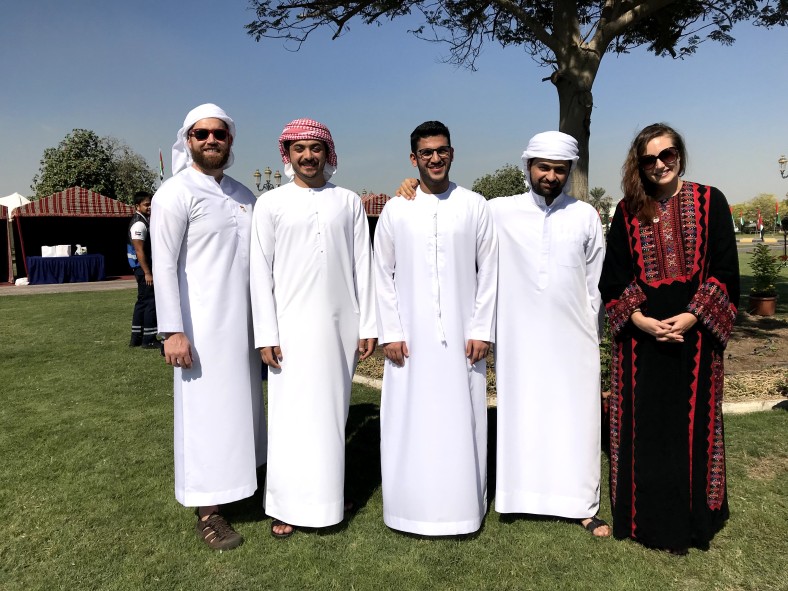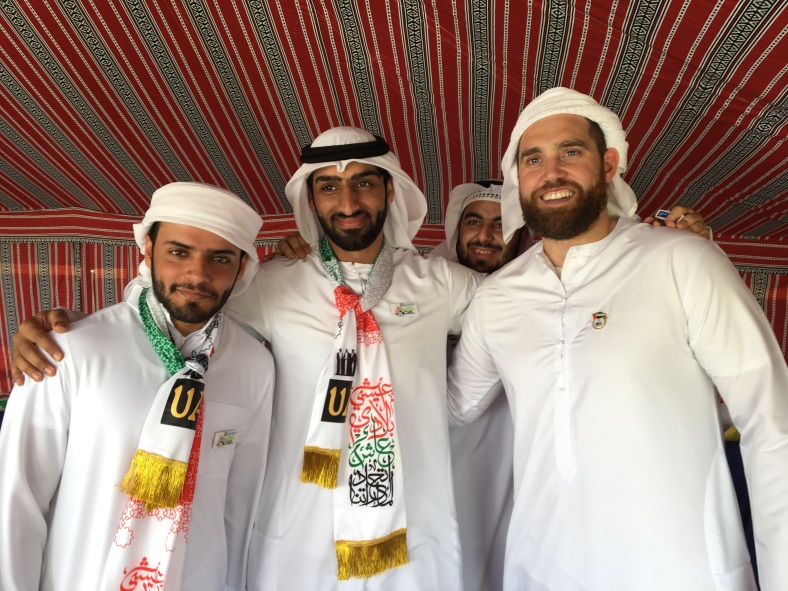
Rebecca and I with the three Sultans.
As the tan Honda Civic cruises down coastal highway E11 in the Emirate of Umm al Quawain, past mangrove marshes and ubiquitous cranes signaling yet more commercial development, Rebecca and I pepper Sultan III with questions: about the Quran, about family and marriage customs, about national dress. He gladly fills us in. Like us, he is eager to participate in some cultural exchange.
We learn that he has 18 siblings. Large families are encouraged as national policy in the UAE, and the government provides generous incentives for support, such as free public university and marriage costs between Emirati nationals. We tell him about our own family members and the exorbitant cost of many American universities. We learn Sultan III is a marketing student who enjoys listening to an eclectic mix of traditional Arabic and American pop music. We tell him about our own musical tastes, but we learn that during the call to prayer (Adhan), which we can faintly hear through closed car windows, I must not play bluegrass music–or any music, for that matter.
And we talk about travel. He hopes to visit the US someday. He’d follow in one of his brother’s footsteps, who spent a month-long honeymoon in the States. “In America, my brother tells me most people were funny and friendly,” he tells us. “I’m glad,” I reply with a sense of relief, thinking how the Trump-spiced soup of xenophobia and ignorance has reared its ugly head in so many ways.
In a nation with the vast majority of residents being expatriates–estimates range between 80 or 90%–it’s common to work and live in the UAE without having much understanding of Emirati culture. You’ll certainly visit Dubai and come away with a strong impression. You’ll be amazed at the Burj Khalifa, the world’s tallest building (at least until a project in Saudi Arabia eclipses it). You might suffer from sore feet after strolling the white marble floors at the world’s largest mall, and you might experience the desert through a “safari” tour. You’ll probably also realize that you’re visiting a place governed through absolute monarchy, and you’d be foolish not to respect local laws and customs.
But if you’re like us, you’ll be intrigued to learn more about the Emiratis, who stand out amongst the crowd, wearing their official national dress–bright white kanduras for men and black abayas for women–in the midst of what is truly a remarkable melting pot. There are reportedly 200 nationalities represented in Dubai.

Abayas for sale in a market in Oman (like it the UAE, women in Oman typically wear a black abaya).
We’ve certainly had good fortune in connecting with several Emirati students at a local men’s university in Sharjah, where there are plenty of western staff and faculty members, but visitors from the US are fairly rare. By hanging out in the campus library where my aunt works, we met three different students named Sultan–we affectionately refer to them as Sultan I, II, and III as a way of differentiating during our conversations :). And two of the Sultans generously offered to bring us on local tours, which is how we found ourselves on the coastal road in Umm Al Quawain.
One week before our tour with Sultan III, Sultan I had given us a tour of his home Emirate Sharjah, where we sampled breakfast sweets and wandered through a local souq (market), where he helped me purchase a jalabiya. Like Sultan III, Sultan I has a desire to learn about the greater world while also sharing insights into Emirati life. Recently, Sultan I also generously loaned me one of his kanduras to wear during the university’s national day celebration–the UAE just turned 46 years old on December 2nd.
The students seemed to appreciate my attempt at wearing their national dress–I certainly wasn’t receiving many puzzled looks, but it was a little tight!

While it was a little tight and a tad short, the Emirati students seemed to enjoy my attempt at donning their national dress.
Back in the car, near the end of the tour with Sultan III, I mentioned that I had yet to try camel milk. His eyes lit up, and he immediately pulled off the highway at the nearest rest area, returning to the car with my cold refreshment. “Very nutritious and natural,” he told me. I liked it–really not too different a taste from cow’s milk. For desert-dwelling Bedouins, camel’s milk, along with dates, are still important sources of nourishment.
As our afternoon outing ended, he told us, “It would be best if all visitors to the UAE were friends with a local Emirati.” We certainly concur.
Reblogged this on Mindful Stew.
LikeLike
We (French business owners in Dubai) concur too.
By the way did you try raw or pasteurized camel milk? Based on your feedback, sounds like it was pasteurized. This version tastes totally plain and is perfect as an ingredient in desserts.
LikeLiked by 1 person